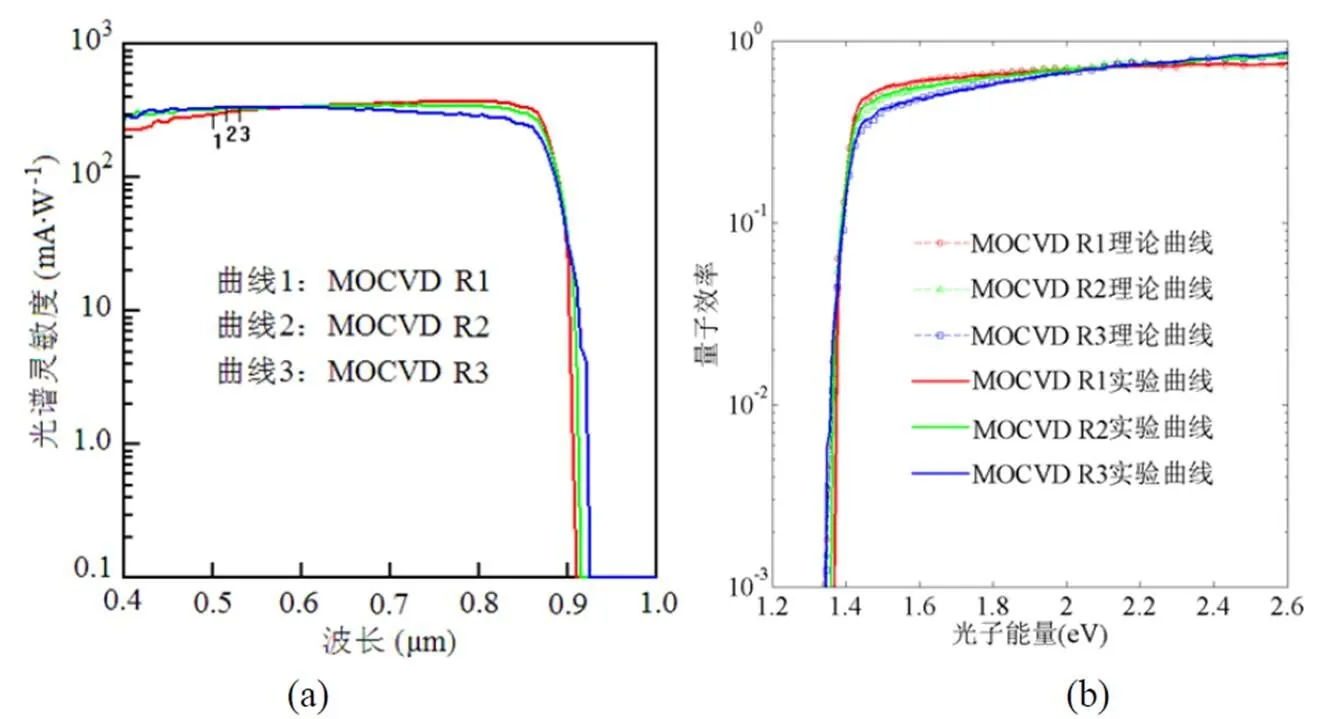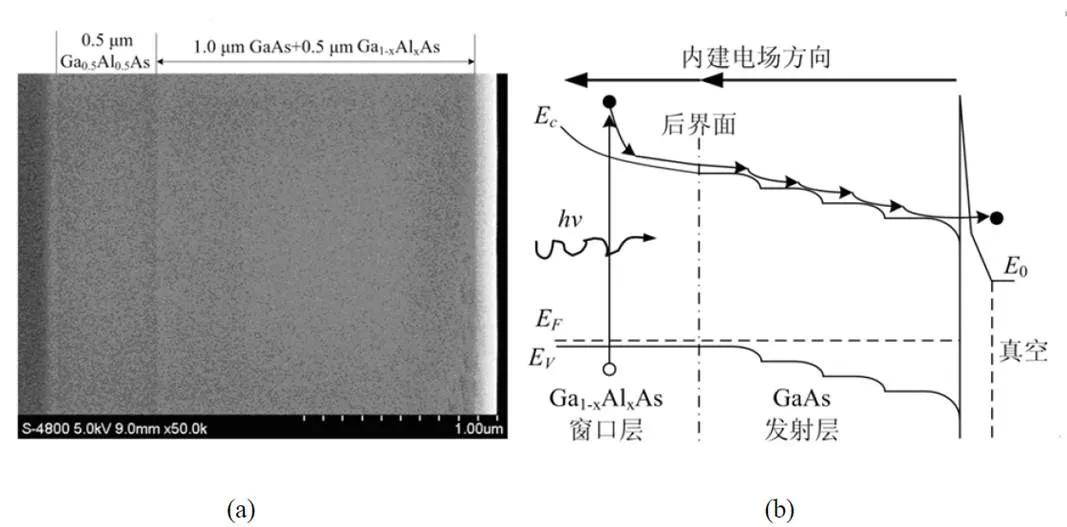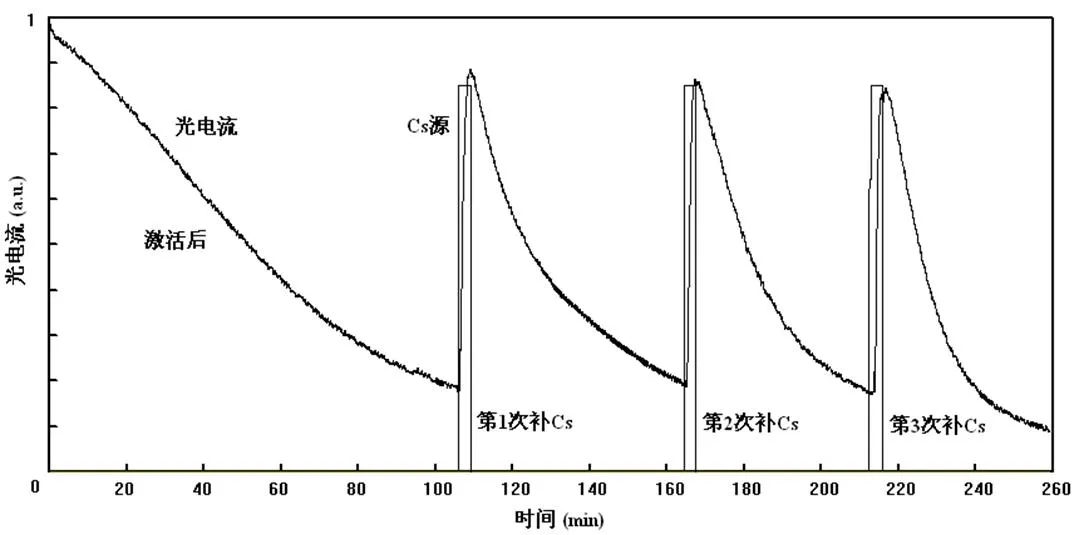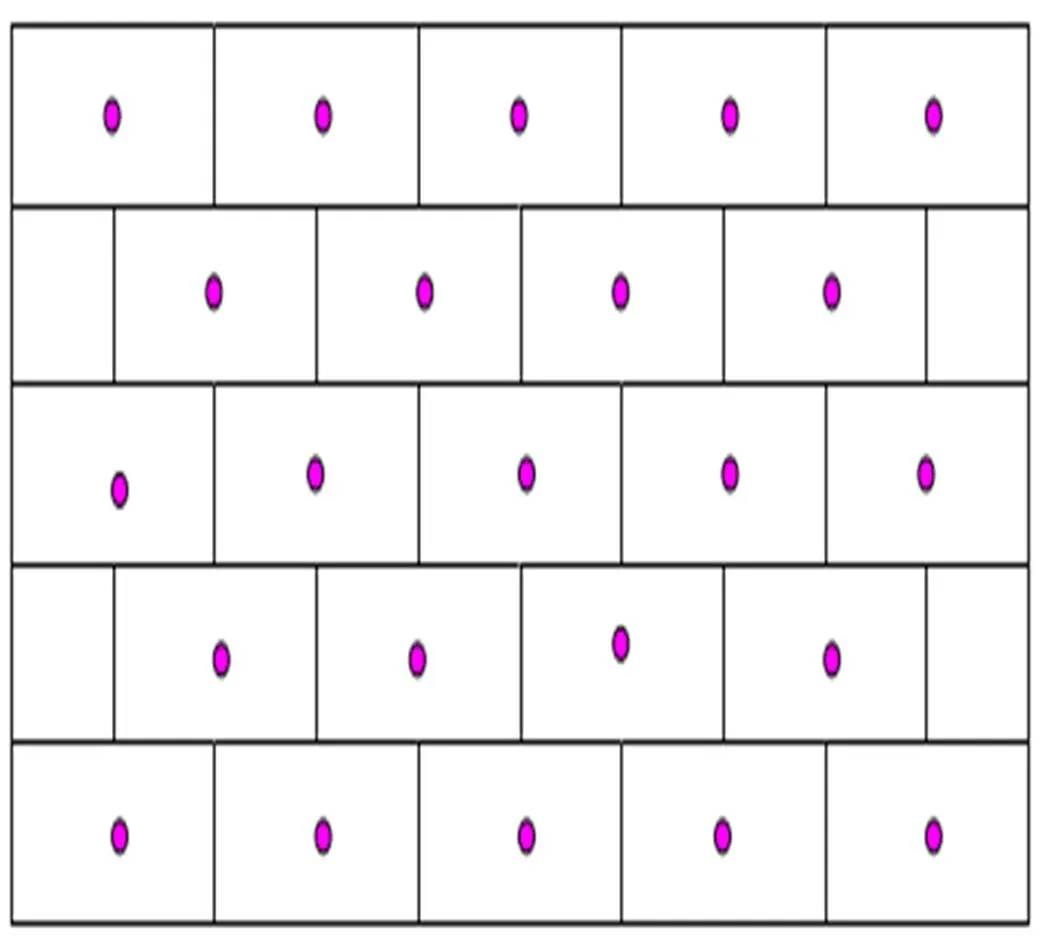负电子亲和势光电阴极50年史话
2015-04-02常本康
常本康
负电子亲和势光电阴极50年史话
常本康
(南京理工大学电子工程与光电技术学院,江苏 南京 210094)
本文是负电子亲和势光电阴极发现50周年的纪念文章,简要回顾了过去的成绩,现在的困难及今后的展望。经过近30年的努力,我国MOCVD生长的反射式GaAs光电阴极的积分灵敏度已达到3516mA/lm,目前存在的困难是光电阴极寿命问题,寿命问题解决了,高性能微光像增强器以及EBAPS数字器件可以缩短与西方的差距。如果高灵敏度长寿命的GaAs:O-Cs光电阴极真正取代了目前大科学装置中的铜阴极,基于我国大科学装置的基础研究才会迎来真正的科学春天。
光电阴极;像增强器;能带结构;光源;EBAPS
0 引言
2015年是负电子亲和势(NEA)光电阴极GaAs发现50周年[1],在过去的50年中,从GaAs、GaN、GaAlAs以及GaAlN都取得了长足的发展,其中MOCVD生长的反射式GaAs光电阴极的积分灵敏度已达到3516mA/lm[2]。
下面将介绍NEA光电阴极过去取得的成就、今天遇到的困难以及未来的展望,重点讨论光电阴极寿命问题。
1 过去取得的成就
自20世纪30到60年代,人们共发现了6种正电子亲和势(PEA)光电阴极,即银-氧-铯(Ag-O-Cs,1930)[3],铯-锑(Cs3Sb,1936),铋-银-氧-铯(Bi-Ag-O-Cs,1938),钠-钾-锑(Na2KSb,1955),钠-钾-锑-铯(Na2KSb[Cs],1955)和钾-铯-锑(K2CsSb,1963)光电阴极[4]。依据W.E.Spicer的光电发射“三步模型”理论,如果材料的有效电子亲和势小于零,则由光照激发产生的光电子只要能从阴极体内运行到表面,就可以发射到真空而无需过剩的动能去克服材料表面的势垒,这样光电子的逸出深度和几率都将大大增加,发射效率将会大幅度提高[5]。这一推测于1965年被J.J.Scheer和J.Vanlaar所证实,他们首先在重掺杂P型GaAs基底上覆盖一层Cs,得到了一种具有高量子效率的新型光电阴极,他们认为这种阴极具有零有效电子亲和势[1]。3年后A.A.Turnbull和G.B.Evans发现用Cs、O交替覆盖GaAs表面比单用Cs可以获得更负的有效电子亲和势和更高的光电发射。在光电阴极的发展史上,GaAs NEA光电阴极的出现可以说是一个重要的里程碑,因为它和以往“靠实验和运气”发现的光电阴极不同,它是理论指导的产物,标志着光电阴极的研究有了质的飞跃。
图1给出了NEA与其它PEA光电阴极的量子效率曲线,NEA GaAs[Cs-O]光电阴极在可见光和近红外区域具有更高的响应能力和更小的暗发射电流,在微光夜视成像器件、真空电子源、电子束平面曝光、线性加速器及第四代光源等领域有着重要的应用。

1: Ag-O-Cs;2: Cs3Sb;3: Bi-Ag-O-Cs;4:[Cs]Na2KSb;5: Na2KSb;6: K2CsSb;7: GaAs[Cs-O]
1995年我们开始搭建光电阴极研究系统,如图2[6];到2000年,利用该系统在P型GaAs基片上获得1000mA/lm左右的反射式积分灵敏度。2005年利用MBE生长的变掺杂GaAs材料,获得1800mA/lm[7-8]。
2005年以后,我们将工作重心转移到反射式模拟透射式光电阴极研究[9-13]。
2008年,利用MBE生长的透射式变掺杂GaAs光电阴极平均积分灵敏度达到1350mA/lm[14-16],2012年,利用MOCVD生长的透射式变掺杂GaAs光电阴极平均积分灵敏度达到2000mA/lm以上,最高2320mA/lm,与美国ITT公司当前报道的水平相当[17-30]。制备的反射式光电阴极的光谱灵敏度与量子效率如图3所示。透射式光电阴极的结构与能带图见图4,并作为一种先进的透射模式梯度掺杂光电阴极被广泛应用[31-35]。

1.显示器;2.四极质谱仪控制箱;3.主机;4.微弱信号处理模块;5.光谱响应电源;6.磁力传输杆;7.四极质谱仪;8.超高真空激活腔室;9.表面分析系统;10.光栅单色仪;11.Cs源程控电流源;12.O源程控电流源;13.氙灯电流源;14.斩波器电源

图3 反射式变掺杂光电阴极的光谱灵敏度(a)与量子效率(b)

图4 透射式变掺杂光电阴极的结构(a)与能带图(b)
2 今天遇到的困难
关于NEA光电阴极研究目前面临的困难,无非是寿命问题、高低温激活的原理问题、六角结构宽带响应光电阴极Cs/O交替光电流不升的问题、禁带宽度与热清洗温度的关系等问题,还可以列出许多,但我认为寿命问题解决了,才有利于其他问题的解决。
以NEA光电阴极为转换面的微光像增强器的寿命,2001年以前欧美主要厂商,例如ITT报道的最小值是10000h,2001年以后,在产品说明中再未见寿命的有关报道[36]。至于利用GaAs光电阴极的EBCCD、EBAPS等新型器件,寿命更是一个秘而不宣的问题。对光源中应用的GaAs:Cs光电阴极,Cornell报道的是100h[37],JLab FEL是30h[38],KER/JAEA是20h[39-40]。由于在现代光源中GaAs:Cs光电阴极的寿命太短,各国又将研究重点转向多碱光电阴极。
关于GaAs光电阴极的寿命问题,各国学者进行了长期研究。Durek等人研究了水蒸汽对GaAs阴极稳定性的影响,并定量地分析了阴极寿命与水蒸气分压强之间的关系,通过拟合得到了如下关系式[41]:

式中:=1.01,0=7800s,0=10-8Pa。该式表明阴极寿命近似与水蒸气分压强成反比。Grames等人在将系统真空度提高到10-10Pa的情况下,阴极寿命达到了2~3周[42]。Wada等人曾通过对阴极所在真空系统充入不同气压的CO2、CO和H2O,观察阴极的光电流随时间的衰减情况[43]。Yee等人认为光电流下降主要是由于Cs的脱附导致阴极表面的Cs/O比及表面层结构发生改变,从而破坏了阴极表面的最佳NEA状态[44-46]。Machuca等人则认为与氧在表面的吸附有关[47-48],Calabres等人也认为导致GaAs光电阴灵敏度下降的主要原因是真空系统中的有害残余气体与阴极表面激活层作用的结果,而不是Cs的脱附[49-50]。
在超高真空系统中,我们研究了不同光照强度时光电流变化,如图5所示[51-52];研究了真空系统中阴极灵敏度衰减后,通过重新铯化后光电流的衰减变化曲线,如图6所示[9];研究了在不同Cs气氛下阴极光电流随时间的衰减,如图7和图8所示[51-52]。

图5 (a)在不同强度光照时阴极光电流和(b)有无光电流流过时阴极光电流

图6 阴极激活和重新铯化后光电流衰减

图7 阴极激活后在一定Cs源电流下强光照阴极光电流衰减
为了研究超高真空系统中GaAs光电阴极光电流衰减,阴极激活后测试了衰减过程中的As 2p3/2、Ga 2p3/2和O 1s谱随时间的变化,并计算了阴极表面各元素的百分含量,测试结果如图9所示,百分含量列于表1中,可知,在4h以后,阴极表面Ga和Cs不变,O含量增加,As含量减少。

图9 激活后阴极衰减过程中As2p3/2、Ga2p3/2和O1s谱
GaAs材料经过高温热清洗后,我认为是富Ga表面,经Cs与O激活后其光电流如图10中1所示;该材料再经过低温热清洗后,是富As表面,激活后的光电流如图10中2所示;比较图10两条曲线,低温热清洗后形成的富As表面更有利于Cs与O激活,以少量的时间和更少的激活次数获得了更好的光电效应。

表1 衰减过程中阴极表面不同元素百分含量随时间的变化

图10 高低温激活过程中的光电流
图10中无论是高温还是低温激活,都是在原子清洁表面获得双偶极子层。以Ga1-xAlAs光电阴极为例,其原子密度为(4.42-0.17)×1022cm-3,p型原子掺杂量通常在1018~1019cm-3量级,可将掺杂浓度粗略估计为0.1%,并将Ga1-xAlAs材料分割为1000个原子组成的立方体单元,长宽高均为14.1443nm,其中包含一个Zn掺杂原子,图11为材料表面掺杂原子分布俯视图。Cs、O激活后与掺杂原子形成[GaAs(Zn):Cs]:O-Cs双偶极子,附近功函数低于周围,光电子更容易从掺杂原子附近逸出,因此表面处光电流并不是均匀的,而是会在掺杂原子附近形成一个峰值,光电发射表现出如图12所示的碎鳞场效应[52-62]。
对照图9与表1,光电流在衰减过程中As的减少与O的增加,是否可以简单归因于双偶极子[GaAs(Zn):Cs]:O-Cs的去极化,最终形成了[GaAs(Zn):X]:O-X,其中X是光电阴极吸附的未知的残余气体,如果我们假设用氢(H)取代X,则形成[GaAs(Zn):H]:H2O,其对光电发射是有害的。按照此假设,在H取代Cs的过程中,由于Cs在表面的位移,掩盖了As,致使在XPS分析中As减少;同样由于Cs在表面的位移,凸显了O,致使在XPS分析中O增加。

图11 Ga1-xAlxAs材料表面掺杂原子分布

图12 光电发射的碎鳞场效应
最好的解决方案是用第一性原理分析现有超高真空系统的残余气体与[GaAs(Zn):Cs]:O-Cs的作用,然后利用现代表面分析方法去验证计算结果。
西方人通过提高超高真空系统的真空度延长了GaAs光电阴极的寿命,目前我们尚无法获得可用的极高真空度的系统,延长光电阴极寿命只能另辟蹊径。
3 未来的展望
在西方,利用NEA光电阴极,完成了微光像增强器、EBCCD及EBAPS等一系列探测器件的研制,已经陆续列装;在现代光源的应用中同样遇到寿命问题,其解决方法是用多碱阴极暂时取代GaAs:Cs阴极,以避开寿命问题的困扰。
对于我们,NEA光电阴极的寿命问题解决了,高性能微光像增强器以及EBAPS等探测器件可以缩短与西方的差距;如果高灵敏度长寿命的GaAs:Cs-O阴极真正取代了目前大科学装置中的铜阴极,基于我国大科学装置的基础研究才会迎来真正的科学春天。
感谢国家自然科学基金重大研究计划培育项目(91533108)及其他面上项目的资助,感谢宗志圆等数十名博士的奉献。此文曾在微光夜视技术国防科技重点实验室学术年会上交流,发表时做了部分修改。
[1] Scheer J.J., Vanlaar J.. GaAs-Cs: a new type of photoemitter[J]., 1965(3): 189-193.
[2] 张益军. 变掺杂GaAs光电阴极研制及其特性评估[D]. 南京: 南京理工大学, 2012.
[3] 薛增泉, 吴全德. 电子发射与电子能谱[M]. 北京: 北京大学出版社, 1993.
[4] Sommer A.H.. Brief history of photoemissive materials[C]//, 1993, 202: 2-17.
[5] Spicer W.E.. Photoemissive, photoconductive, and absorption studies of alkali-antimony compounds[J]., 1958, 112(1): 114-122.
[6] 宗志园. NEA光电阴极性能评估与激活工艺研究[D]. 南京: 南京理工大学, 2000.
[7] 杜晓晴. 高性能GaAs光电阴极研究[D]. 南京: 南京理工大学, 2005.
[8] 杜晓晴, 常本康, 邹继军, 等. 利用梯度掺杂获得高量子效率的GaAs光电阴极[J]. 光学学报, 2005, 25(10): 1411-1414.
[9] 邹继军. GaAs光电阴极理论及其表征技术研究[D]. 南京: 南京理工大学, 2007.
[10] Zou Jijun, Chang Benkang. Gradient doping negative electron affinity GaAs photocathodes[J]., 2006, 45(5): 054001-5.
[11] 邹继军, 常本康, 杨智. 指数掺杂GaAs光电阴极量子效率的理论计算[J]. 物理学报, 2007, 56(5): 2992-2997.
[12] ZOU Ji-Jun, CHANG Ben-Kang, YANG Zhi, et al. Evolution of photocurrent during coadsorption of Cs and O on GaAs (100)[J]., 2007, 24(6): 1731-1734.
[13] 邹继军, 常本康, 杜晓晴. MBE梯度掺杂GaAs光电阴极实验研究[J]. 真空科学与技术学报, 2005, 25(6): 401-404.
[14] 杨智. GaAs光电阴极智能激活与结构设计研究[D]. 南京: 南京理工大学, 2010.
[15] Yang Zhi, Chang Benkang, Zou Jijun, et al. Comparison between gradient-doping GaAs photocathode and uniform-doping GaAs photocathode[J]., 2007, 46(28): 7035-7039.
[16] 杨智, 邹继军, 常本康. 透射式指数掺杂GaAs光电阴极最佳厚度研究[J].物理学报, 2010, 29(6): 4290-4295.
[17] 张益军. 变掺杂GaAs光电阴极研制及其特性评估[D]. 南京: 南京理工大学, 2012.
[18] Zhang Yijun, Chang Benkang, Niu Jun, et al. High-efficiency graded band-gap AlGa1-As/GaAs photocathodes grown by metalorganic chemical vapor deposition[J]., 2011, 99: 101104.
[19] Zhang Yijun, Zou Jijun, Niu Jun, et al. Photoemission characteristics of different-structure reflection-mode GaAs photocathodes[J]., 2011, 110: 063113.
[20] Zhang Yijun, Niu Jun, Zhao Jing, et al. Influence of exponential-doping structure on photoemission capability of transmission-mode GaAs photocathodes[J]., 2010, 108: 093108.
[21] Zhang Yijun, Niu Jun, Zou Jijun, et al. Variation of spectral response for exponential-doped transmission-mode GaAs photocathodes in the preparation process[J]., 2010, 49(20): 3935-3940.
[22] Zhang Yijun, Chang Benkang, Yang Zhi, et al. Annealing study of carrier concentration in gradient-doped GaAs/GaAlAs epilayers grown by molecular beam epitaxy[J]., 2009, 48(9): 1715-1720.
[23] Zhang Yi-Jun, Niu Jun, Zhao Jing, et al. Improvement of photoemission performance of a gradient-doping transmission- mode GaAs photocathode[J]., 2011, 20(11): 118501.
[24] 张益军, 牛军, 赵静, 等. 指数掺杂结构对透射式GaAs光电阴极量子效率的影响研究[J]. 物理学报, 2011, 60(6): 067301-6.
[25] 赵静. 透射式GaAs光电阴极的光学与光电发射性能研究[D]. 南京: 南京理工大学, 2013.
[26] Zhao Jing, Zhang Yijun,Chang Benkang, et al. Comparison of structure and performance between extended blue and standard transmission-mode GaAs photocathode modules[J]., 2011, 50(32): 6140-6145.
[27] Zhao Jing, Chang Benkang, Xiong Yajuan, et al. Influence of the antireflection, window, and active layers on optical properties of exponential-doping transmission-mode GaAs photocathode modules[J]., 2012, 285(5): 589-593.
[28] Zhao Jing, Chang Benkang, Xiong Yajuan, et al. Spectral transmittance and module structure fitting for transmission-mode GaAs photocathode[J]., 2011, 20(4): 500-506.
[29] 赵静, 张益军, 常本康, 等. 高性能透射式GaAs光电阴极量子效率拟合与结构研究[J]. 物理学报, 2011, 60(10): 107802-7.
[30] 赵静, 常本康, 张益军, 等. 透射式蓝延伸GaAs光电阴极光学结构对比[J]. 物理学报, 2012, 61(3): 037803-6.
[31] Schwede J. W., Sarmiento T., Narasimhan V. K., et al. Photon-enhanced thermionic emission from heterostructures with low interface recombination[J]., 2013, 4(3):67-88.
[32] Siddharth K, Laurent B, Luca C, et al. Ultrabright and Ultrafast III-V Semiconductor Photocathodes[J]., 2014, 112(9): 219-233.
[33] Chanlek N, Herbert J D, Jones R M, et al. The degradation of quantum efficiency in negative electron affinity GaAs photocathodes under gas exposure[J]., 2014, 47(5):133-140.
[34] Rao T, Dowell D H. An Engineering Guide To Photoinjectors[J]., 2014.
[35] Chen Z, Jiang X, Dong S, et al. Insight into the photoelectron angular dependent energy distribution of negative-electron-affinity InP photocathodes[J]., 2014, 104(2): 021120 - 021120-4.
[36] MX-11769(F9815 Series)[R/OL]. http//www.ITT.com/. 2001.
[37] M. Tigner. A Possible Apparatus for Electron-Clashing Experiments[J]., 1965, 137: 1228-1231.
[38] Neil G R, Bohn C L, Benson S V, et al. Sustained Kilowatt Lasing in a Free-Electron Laser with Same Cell Energy Recovery[J]., 1999, 84(4): 662-665.
[39] M. Sawamura, Ryoichi Hajima, N Kikuzawa, et al. Status and Development for the JAERI ERL-FEL for High-Power and Long-Pulse operation[C]//, 2004: 1723-1725.
[40] Aleksandrovich V. N., Bolotin V.P., Aleksandrovich K. D. et al., Status of the Novosibirsk Terahertz FEL[C]//, 2004:226-228
[41] D. Durek, F. Frommberger, T. Reichelt, et al. Degradation of a gallium-arsenide photoemitting NEA surface by water vapour[J]., 1999, 143: 319-322.
[42] Grames J, Adderley P, Baylac M, et al. Status of the Jefferson Lab Polarized Beam Physics Program and Preparations for Upcoming Parity Experiments[C]//2002,, NY (US), 09/09/2002--09/14/2002, 2003:1047-1052.
[43] T. Wada, T. Nitta, T. Nomura. Influence of exposure to CO,CO2and H2O on the stability of GaAs photocathodes[J]., 1990, 29(10): 2087-2090.
[44] E. M. Yee, D. A. Jackson. Photoyeild decay characteristics of a cesiated GaAs[J]., 1972, 15: 245-247
[45] F. C. tang, M. S. Lubell, K. Rubin, et al. Operating experience with a GaAs photoemission electron source[J]., 1986, 57(12): 3004-3011.
[46] D. C. Rodway, M. B. Allenson, In situ surface study of the activating layer on GaAs(Cs,O) photocathodes[J]., 1986, 19: 1353-1371.
[47] F. Machuca, Z. Liu, Y. Sun, et al. Role of oxygen in semiconductor negative electron affinity photocathodes[J]., 2002, 20(6): 2721-2725.
[48] F. Machuca, Z.Liu, Y.Sun, et al. Oxygen species in Cs/O activated gallium nitride (GaN) negative electron affinity photocathodes[J]., 2003, 21(4): 1863-1869.
[49] R.Calabres, V.Guidi, P.Lenisa, et al. Surface analysis of a GaAs electron source using Rutherford backscattering spectroscopy[J]., 1994, 65(3): 301-302.
[50] R.Calabres, G.Ciullo, V.Guidi, et al. Long-lifetime high-intensity GaAss photosource[J]., 1994, 65(2): 343-348.
[51] Zou Jijun, Chang Benkang, Chen Huailin, et al. Variation of quantum yield curves of GaAs photocathodes under illumination[J]., 2007, 101: 033126-6.
[52] 邹继军, 常本康, 杨智, 等. GaAs光电阴极在不同强度光照下的稳定性[J]. 物理学报, 2007, 56(10): 6109-6113.
[53] 鱼晓华. NEA Ga1-xAlAs光电阴极中电子与原子结构研究[D]. 南京: 南京理工大学, 2015.
[54] Xiaohua Yu, Yujie Du, Benkang Chang, et al. Study on the electron structure and optical properties of Ga0.5Al0.5As (100) β2(2×4) reconstruction surface[J]., 2013, 266: 380-385.
[55] Xiaohua Yu, Yujie Du, Benkang Chang, et al. The adsorption of Cs and residual gases on Ga0.5Al0.5As (001) β2 (2×4) surface: A first-principles research[J]., 2014, 290: 142-147.
[56] Yu Xiaohua, Chang Benkang, Wang Honggang, et al. Geometric and electronic structure of Cs adsorbed Ga0.5Al0.5As (001) and (011) surfaces: a first principles research[J]., 2014, 25: 2595-2600.
[57] Yu Xiaohua, Chang Benkang, Chen Xinlong, et al. Cs adsorption on Ga0.5Al0.5As(001)β2 (2×4) surface: A first-principles research[J]., 2014, 84: 226-231.
[58] Yu Xiaohua, Ge Zhonghao, Chang Benkang, et al. Electronic structure of Zn doped Ga0.5Al0.5As photocathodes from first-principles[J]., 2013, 164: 50-53.
[59] Yu Xiaohua, Chang Benkang, Wang Honggang, et al. First principles research on electronic structure of Zn-doped Ga0.5Al0.5As(001)β2(2×4) surface[J]., 2014, 187: 13-17.
[60] Yu Xiaohua, Ge Zhonghao, Chang Benkang, et al. First principles calculations of the electronic structure and optical properties of (001), (011) and (111) Ga0.5Al0.5As surfaces[J]., 2013, 16: 1813-1820.
[61] Yu Xiaohua, Du Yujie, Chang Bengkang, et al. Study on the electronic structure and optical properties of different Al constituent Ga1-xAlAs[J]., 2013, 124: 4402-4405.
[62] Yu Xiaohua, Ge Zhonghao, Chang Benkang, et al. First principles study on the influence of vacancy defects on electronic structure and optical properties of Ga0.5Al0.5As photocathodes[J]., 2014, 125: 587-592.
Negative Electron Affinity Photocathode of Fifty Years
CHANG Ben-kang
(,,210094,)
This article is the fifty year anniversary of the discovery photocathode of negative electron affinity, and a brief review of the past achievements, the present difficulties and future outlook.After nearly 30 years of efforts, the integral sensitivity of the MOCVD growth of GaAs reflection-mode photocathode in China has reached 3516mA/lm.Existing difficulties is photocathode life problem, life problem resolved, LLL image intensifier and EBAPS digital device of high performance can shorten the gap with the West.If the GaAs:O-Cs photocathode of high sensitivity and long life truly replace the copper cathode in the current big scientific device, based on the basic research of China's big scientific device will usher in a real scientific spring.
photocathode,image intensifier,band structure,optical source,EBAPS
O462.3
A
1001-8891(2015)10-0801-06
2015-09-15;
2015-10-11
常本康(1950-),博士,教授,博导,主要研究方向为微光夜视和多光谱图像融合技术。
国家自然科学基金重大研究计划培育项目,编号:91533108。
